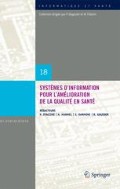Abstract
Pharmacovigilance is the activity related to the collection, analysis and prevention of adverse drug reactions (ADRs) induced by drugs. Beside other methods, statistical methods are used to detect new ADRs in the framework of signal detection. Groupings of terms containing similar ADRs allow to increase the signal intensity and to improve the detection of new ADRs. SMQs have become reference groupings in the field of pharmacovigilance. They are built on the MedDRA terminology and thanks to the study of scientific literature. Even if SMQs are built manually by experts, they still show some shortcomings: they tend to be over-inclusive and thus become too sensitive, although they can also miss several relevant terms. Moreover, the spectrum of available SMQs is limited. The objective of this work is to propose an automated method for a flexible creation of groupings of terms. This method is based on exploitation of the semantic distance between MedDRA terms. In a first experience, we used ARD terms alone and obtained results with a high precision (mean 74% within the interval [49; 91]). In a second experience, we used ADR terms and their formal definitions and this worsened the results because the semantic information within definitions may be missing. We assume that more exhaustive definitions will have a positive effect on results.
Preview
Unable to display preview. Download preview PDF.
Références
Bate A, Lindquist M, Edwards I, Olsson S, Orre R, Lansner A, De Freitas R. A bayesian neural network method for adverse drug reaction signal generation. Eur J Clin Pharmacol 1998; 54(4): 315–21
Meyboom R, Lindquist M, Egberts A, Edwards I. Signal selection and follow-up in pharmacovigilance. Drug Saf 2002; 25(6): 459–65
Hauben M, Bate A. Decision support methods for the detection of adverse events in post-marketing data. Drug Discov Today 2009; 14(7–8): 343–57
Fescharek R, Kübler J, Elsasser U, Frank M, Güthlein P. Medical dictionary for regulatory activities (MedDRA): Data retrieval and presentation. Int J Pharm Med 2004; 18(5): 259–269
CIOMS. Development and Rational Use of Standardised MedDRA Queries (SMQs): Retrieving Adverse Drug Reactions with MedDRA. Rapport interne, CIOMS, 2004
Mozzicato P. Standardised MedDRA queries: their role in signal detection. Drug Saf 2007; 30(7): 617–9
Pearson R, Hauben M, Goldsmith D, Gould A, Madigan D, O’Hara D, Reisinger S, Hochberg A. Influence of the MedDRA hierarchy on pharmacovigilance data mining results. Int J Med Inform 2009; 78(12): 97–103
Yuen N, Fram D, Vanderwall D, Almenoff J. Do standardized MedDRA queries add value to safety data mining? ICPE 2008, August 17–20 2008, Copenhagen
Alecu I, Bousquet C, Jaulent MC. A case report: using Snomed CT for grouping adverse drug reactions terms. BMC Med Inform Decis Mak 2008; 8(S1): S4
Bousquet C, Henegar C, Louet A, Degoulet P, Jaulent MC. Implementation of automated signal generation in pharmacovigilance using a knowledge-based approach. Int J Med Inform 2005: 74(7–8): 563–71
Iavindrasana J, Bousquet C, Degoulet P, Jaulent MC. Clustering WHO-ART terms using semantic distance and machine algorithms. AMIA Annu Symp Proc 2006; 369–73
Brown E, Wood L, Wood S. The medical dictionary for regulatory activities (MedDRA). Drug Saf. 1999; 20(2): 109–17
Stearns M, Price C, Spackman K, Wang A. Snomed clinical terms: overview of the development process and project status. Proc AMIA Symp. 2001; 662–666
NLM. UMLS Knowledge Sources Manual. National Library of Medicine, Bethesda, Maryland. 2008. Disponible sur: 〈http://www.nlm.nih.gov/research/umls/〉 (Consulté le 31.12.2010)
Rada R, Mili H, Bicknell E, Blettner M. Development and application of a metric on semantic nets. IEEE Transactions on Systems, Man and Cybernetics 1989; 19: 17–30
Spackman K, Campbell K. Compositional concept representation using Snomed: Towards further convergence of clinical terminologies. Proc AMIA Symp 1998: 740–4
Petiot D, Burgun A, Le Beux P. Modelisation of a criterion of proximity: Application to medical thesauri. In: Medical Informatics Europe’ 96. Brender J (ed). IOS Press. 1996: 149–53
Lebart L, Salem A. Statistique textuelle. Paris: Dunod, 1994
Trifiro G, Pariente A, Coloma P, Kors J, Polimeni G, Miremont-Salamé G et al. Data mining on electronic health record databases for signal detection in pharmacovigilance: Which events to monitor? Pharmacoepidemiol Drug Saf 2009; 18(12): 1176–84
Author information
Authors and Affiliations
Corresponding author
Editor information
Editors and Affiliations
Rights and permissions
Copyright information
© 2011 Springer-Verlag France
About this chapter
Cite this chapter
Dupuch, M., Jamet, A., Jaulent, MC., Fescharek, R., Grabar, N. (2011). Exploitation de la distance sémantique pour la création de groupements de termes en pharmacovigilance. In: Staccini, P.M., Harmel, A., Darmoni, S.J., Gouider, R. (eds) Systèmes d’information pour l’amélioration de la qualité en santé. Informatique et Santé, vol 1. Springer, Paris. https://doi.org/10.1007/978-2-8178-0285-5_3
Download citation
DOI: https://doi.org/10.1007/978-2-8178-0285-5_3
Publisher Name: Springer, Paris
Print ISBN: 978-2-8178-0284-8
Online ISBN: 978-2-8178-0285-5

